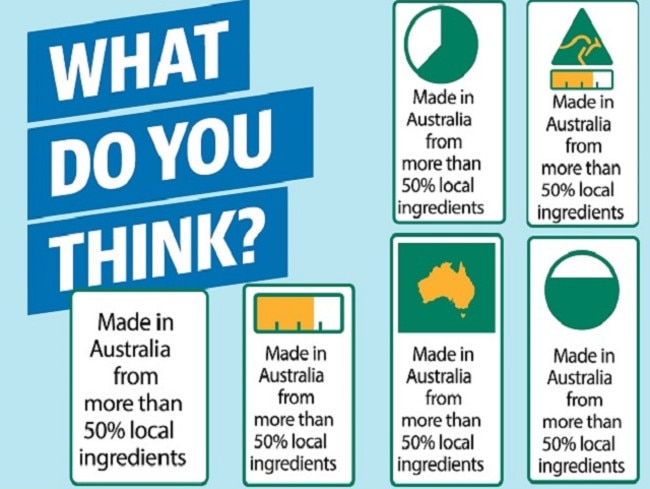43 new australian food labels
Labelling laws | NSW Food Authority * Food labels are legally required to show the name and Australian or New Zealand business address of the manufacturer or supplier (packer or vendor importer) plus the lot and batch number of the food (or date coding) to enable efficient food recalls. Food is recalled when it poses a possible public health and safety risk to consumers. Food labels - Better Health Channel Food labels carry useful information to help you make informed choices about what you and your family eat and drink. Most packaged foods are required to have a label with this information, but the information required depends on the food type. ... Food Standards Australia New Zealand (FSANZ) Tel. (02) 6271 2222 ;
Country of origin food labels | Department of Industry, Science and ... Australian food labels must easily convey where food is grown, produced, made or packed. This helps consumers make informed decisions about the food they buy. Requirements and tools for business If you sell food in retail stores in Australia, you will need to consider if your products need country of origin food labels.

New australian food labels
Country of origin labelling - Food Standards The Australian Government introduced a country of origin food labelling system under Australian Consumer Law on 1 July 2016. Country of origin labelling requirements for food is in the Country of Origin Food Labelling Information Standard 2016, under the Competition and Consumer Act 2010. These requirements became mandatory on 1 July 2018. Changes to food labelling laws - The Australian Made Campaign From July 1, 2016, the Australian Government incorporated the Australia Made Campaign Ltd's (AMCL) Australian Made, Australian Grown (AMAG) kangaroo logo into a new country of origin label, which, on July 1, 2018, became mandatory for most Australian food products sold in Australia. Australia - Labeling/Marking Requirements The joint Australia New Zealand Food Standards Code requires all packaged food to be labeled with nutritional information on how much fat, protein, energy, carbohydrates, and salt is in the product. Labels must also show the percentage of key ingredients and all the main ingredients that may cause allergies.
New australian food labels. Farmers hope new food labelling laws spur consumers to buy more ... The labels clearly spell out where food is from, and which foods are grown, produced or made in Australia. All priority foods must display new country-of-origin labels. These are staple foods ... Food labelling FAQs | ACCC The Country of Origin Food Labelling Information Standard (Standard) commenced on 1 July 2016. The Standard establishes a new system for the country of origin labelling of food products sold in Australia. Businesses have up to two years to transition to the labelling requirements set out in the Standard. Nutrition information panels - Food Standards Carbohydrates are in foods like bread, cereals, rice, pasta, milk, vegetables and fruit. Carbohydrates in the NIP includes starches and sugars. Foods with high amounts of starches are white, wholemeal and wholegrain varieties of breads, cereal, rice and pasta, root vegetables and legumes. Sugars Food Labelling & Allergen Guide - Australian Food and Grocery Council The Food Industry Guide to Allergen Management and Labelling offers guidance in managing allergens. It's relevant to those involved in the supply, handling, production, import and sale of foods. It was first development by the AFGC in 2007 but an updated edition was jointly published by the AFGC and Allergen Bureau in April 2021.
Allergen labelling - Food Standards peanuts tree nuts milk eggs sesame seeds fish shellfish soy lupin wheat. The Food Standards Code requires suppliers to declare these foods on labels whenever they are present as: ingredients components of food additives components of processing aids Food labelling - WA Health, Government of Western Australia Food labels provide a wide range of information to help consumers make food choices. Food Standards Australia New Zealand sets food labelling requirements in the Food Standards Code (external site) . These Labelling Standards are enforced by local government Environmental Health Officers. The Food Standards Code includes: Country of origin food labelling | business.gov.au Country of origin food labelling can let consumers know which country a product came from. If you supply food for retail sale in Australia then the Country of Origin Food Labelling Information Standard 2016 (the Information Standard) may apply to your products. If the Information Standard does not apply to your product, then the Australia New Zealand Food Standards Code will apply. New Australian food labels will list local food content but not foreign ... NEW food labels will reveal only the "Australian-ness" of groceries - meaning the consumers who bought contaminated berries earlier this year would not have known they were from China. The Abbott Government yesterday revealed that from next April 1 most groceries will have to include a label to explain the percentage of Australian ingredients.
Food industry hesitant about new Australian food labelling system Australian food industry representative body the Australian Food and Grocery Council (AFGC) has warned the Australian government that "serious flaws" remain and need to be resolved if an effective Front-of-Pack nutrition labelling system (FoPL) is to be implemented. However, the new system has been tentatively welcomed by Australia's confectionary industry. Iconic Australian Food | 17 Australian Foods You Should Try 11. BBQ's. When you think of Australia you think of surfing, nice weather, kangaroo's and the barbecue. "Throw another shrimp on the barbie" is a quote often said even though Australians call them prawns and not shrimps! In fact, many Aussies dislike this phrase and claim that it's just another Australian stereotype. Country of origin food labelling resources | business.gov.au Country of origin statement. A country of origin statement is a text explanation of where the food product came from. Products that can't use or do not need to use the three- or two-component standard mark use a country or origin statement. Imported priority foods must, as a minimum, carry a country of origin statement in a clearly defined ... New Australian Food Labels And How To Read Them There are five new labels in total. The following three are identified with a kangaroo symbol: GROWN IN AUSTRALIA - You're good to go with this option as this label means your food is 100% grown in Australia. PRODUCT OF AUSTRALIA - Think canned or bagged goods where the ingredients are 100% Australian and they've been processed here too.
Food labelling - healthywa.wa.gov.au The supplier's name and their Australian or New Zealand business address is required on food package labels. The term 'supplier' includes the packer, manufacturer, vendor (the business selling the food) or importer (the business bringing the food into Australia).
New Australian Food Labels And How They Affect You There are five new labels in total. The following three are identified with a kangaroo symbol: GROWN IN AUSTRALIA - You're good to go with this option as this label means your food is 100% grown in Australia. PRODUCT OF AUSTRALIA - Think canned or bagged goods where the ingredients are 100% Australian and they've been processed here too.

PEARS SOAP AD NELL WILSON AUSTRALIAN Vintage Advertising 1952 Original Ad | Australian vintage ...
Food Labelling | Foodstream To access these services, see "Standard Labelling Services" below (or call us on 07 3137 1433, or use the contact form on this page If a more complete service is required - such as to include brand/graphic design - we work with other professionals in this area - such as Renee Weaver of Evolve Brand Design. Standard Labelling Services:
Labelling - Food Standards The Food Standards Code includes the general labelling and information requirements (Chapter 1 of the Code) that are relevant to all foods, and sets out which requirements apply in different situations (for example food for retail sale, food for catering purposes, or an intra-company transfer).
Food labelling | NSW Food Authority New requirements for labelling the most common allergens in food commenced on 25 February 2021. The changes to the Food Standards Code will help people find allergen information on food labels more quickly and easily, so they can make informed and safe food choices. For more information see Changes to allergen labelling .
Food and beverage product news in Australia and beyond | Gallery - 9Kitchen July 5, 2022: If you're looking for a healthier alternative to instant noodles, this is the news you've been waiting for. Health food brand Slendier has just launched Australia's "healthiest-ever" instant noodles. The new noodle range ticks all the boxes for things we love about instant noodles (full of flavour, quick and easy) but is lower on carbs, calories and sodium than other comparable ...
Food labelling - Health.vic Food labelling Key messages All packaged foods sold in Australia must comply with the labelling requirements of the Australia New Zealand Food Standards Code, which applies in Victoria through the Food Act 1984. Food labels must carry essential information, so that consumers are informed of the nature and properties of foods before they buy.
Changes to allergen labelling | NSW Food Authority New requirements for labelling the most common allergens in food commenced on 25 February 2021. The changes to the Food Standards Code will help people find allergen information on food labels more quickly and easily, so they can make informed and safe food choices. The changes include:
Labelling - Food Standards Food labels also help to protect public health and safety by displaying information such as use by dates, ingredients, certain allergens, instructions for storage and preparation, and advisory and warning statements. FSANZ sets standards for what information must be on food labels. FSANZ has developed information on a range of labelling topics.
Australia - Labeling/Marking Requirements The joint Australia New Zealand Food Standards Code requires all packaged food to be labeled with nutritional information on how much fat, protein, energy, carbohydrates, and salt is in the product. Labels must also show the percentage of key ingredients and all the main ingredients that may cause allergies.
Changes to food labelling laws - The Australian Made Campaign From July 1, 2016, the Australian Government incorporated the Australia Made Campaign Ltd's (AMCL) Australian Made, Australian Grown (AMAG) kangaroo logo into a new country of origin label, which, on July 1, 2018, became mandatory for most Australian food products sold in Australia.
Country of origin labelling - Food Standards The Australian Government introduced a country of origin food labelling system under Australian Consumer Law on 1 July 2016. Country of origin labelling requirements for food is in the Country of Origin Food Labelling Information Standard 2016, under the Competition and Consumer Act 2010. These requirements became mandatory on 1 July 2018.

Symbols on #foodlabels are everywhere but what do they *really* mean? Check out our new glossary ...

New changes to Country of Origin Food Labelling, taking place throughout Australia | SBS Your ...








Post a Comment for "43 new australian food labels"